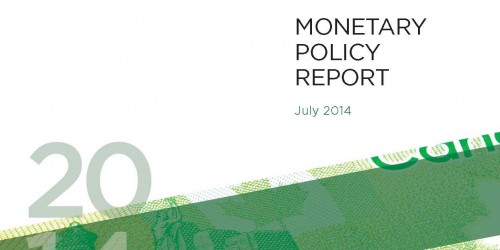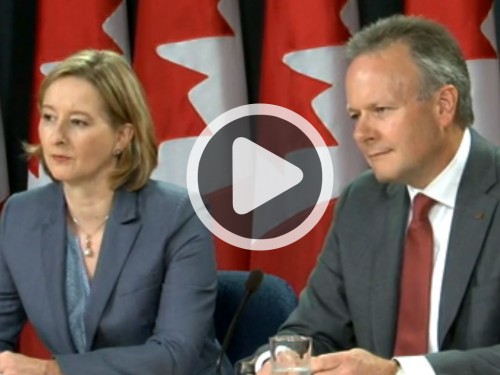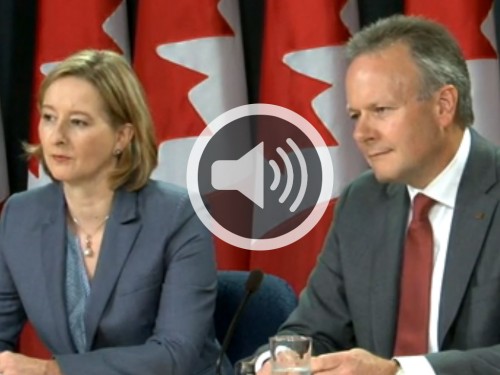Release of the Monetary Policy Report
Good morning. Carolyn and I are pleased to be here with you today to discuss the July Monetary Policy Report, which the Bank published this morning.
Before we take your questions, let me take a minute to share our thinking around how our quarterly analysis of growth and inflation feeds into our monetary policy decisions.
I’ll begin by reminding you that monetary policy must be forward looking. That’s because policy actions take time - around 6-8 quarters - to work their way through the economy and have their full effect on inflation.
Let’s look back to last fall, when measured inflation was very low - total inflation was just 0.7 per cent last October, and core inflation was 1.2 per cent. Inflation had been running below target for some time and the economy was carrying a lot of excess capacity, which raised the risk that inflation could fall even further.
At the time, even though we presented a projection in which the forecast risks around inflation were roughly balanced, we gave greater weight to the downside risks than the upside ones. Because inflation had been persistently below target, a negative shock would have mattered more than a positive shock, as inflation would have been driven even farther away from target. In short, we attached greater weight to the downside risks because inflation’s starting point was already relatively far from home, and had been for some time.
This situation persisted during the winter months, but during the spring, inflation began to move up. Six weeks ago, when we last set the target for the overnight rate, the inflation numbers we were working with were April’s. They showed total CPI inflation at 2 per cent and core at 1.4 per cent. Although we had expected inflation to move up due to various one-off factors, including the effects of last year’s decline in the dollar, the increases arrived a bit faster than we had presented in the April MPR.
At our announcement date six weeks ago, we did not have a new projection in which to work out all the details and balance the forecast risks. The economy still had a significant degree of excess capacity, which acts to pull inflation down over time. Further, relative to our projection in the April MPR, we were monitoring growing downside risks on global economic activity. We believed that as we worked toward our next projection, published in today’s MPR, we would probably be downgrading the economic outlook. That would mean a longer period of economic slack in Canada, and would translate into a downside risk to inflation later in the forecast horizon.
Accordingly, six weeks ago, even though measured inflation had already ticked up, and looked likely to tick up even more, we indicated that the downside risks to our inflation outlook remained as important as before. In effect, the risks associated with the starting point for inflation had diminished, but the downside risks to the underlying fundamental drivers of inflation were growing.
Today, our Report notes that total CPI inflation has moved to 2.3 per cent, and core inflation to 1.7 per cent.
This pickup in measured inflation is attributable to the temporary effects of higher energy prices, exchange rate pass-through and other sector-specific shocks. It is not coming from any change in domestic economic fundamentals.
Today’s MPR presents a new economic projection in which there are both upside and downside risks to the inflation outlook. We believe these risks are roughly balanced. The downside risks to inflation associated with a below-target starting point have clearly diminished. The projection now includes a lower track for global economic activity, and a slower return of our economy to its full potential. Our serial disappointment with global economic performance for the past several years of course means that we remain preoccupied with downside risks to economic activity and the fundamental drivers of inflation.
As the temporary effects pushing inflation up begin to dissipate during 2015, unless the economy's slack is absorbed over a reasonable timeframe, inflation will drift back down well below target. This will require above-potential economic growth fuelled by rising exports, followed by investment in new capacity.
We believe that the ingredients are present for an eventual return to balanced and sustainable growth, with inflation on target, in 2016. We are anticipating that global demand will strengthen and, with the lower Canadian dollar, indeed, will lead to a pickup in Canadian exports and business investment.
We expect real GDP growth to average around 2 1/4 per cent during 2014 - 2016. The economy is expected to reach full capacity around mid-2016, a little later than we said in April.
Meanwhile, household imbalances continue to evolve constructively and recent data are broadly consistent with a soft landing in Canada’s housing market.
For the inflation target to be achieved on a sustained basis in 2016, the economy must reach and remain at full capacity. Closing the output gap over this time frame is reliant on continued stimulative monetary policy and hinges critically on stronger exports and business investment.
Weighing these considerations within the Bank’s risk-management framework, the monetary policy stance remains appropriate and the target for the overnight rate remains at 1 per cent. The Bank is neutral with respect to the timing and direction of the next change to the policy rate, which will depend on how new information influences the outlook and assessment of risks.
And now, with that, Carolyn and I would be pleased to answer your questions.


